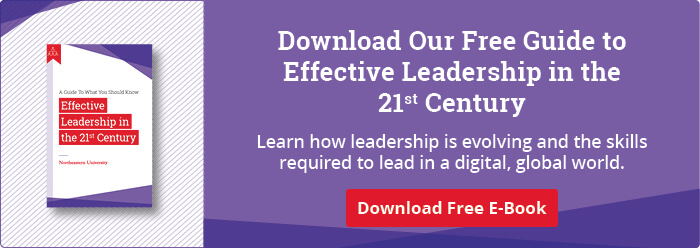Les Stein, PhD and assistant teaching professor in Northeastern’s Master of Science in Leadership program, shares his insights on the importance of strong leadership in times of crisis.
Amid a crisis—be it global, national, or organizational—great leaders are grounded in reality, understand the importance of synergy, demonstrate confidence in their ability to overcome unexpected and difficult challenges, and have a vision for the future. It is important to understand that although no two crises are alike, and each one requires a different response, there are significant similarities in the leadership styles that will most effectively navigate them.
The terrorist attack on September 11, 2001, came without warning to the general public, much like the crisis surrounding Johnson & Johnson in 1982, when some of the company’s Tylenol capsules were found laced with potassium cyanide poison. In both cases, immediate and responsive leadership addressed the emergency, and the public was provided with up-to-date information at the local and national levels. This is the kind of leadership we expect from those in power, but it does not always come naturally to those who are at the top, as exemplified by the unmitigated leadership disaster that accompanied the BP oil spill of 2010 in the Gulf of Mexico.
The COVID-19 pandemic is also providing us with valuable lessons in crisis leadership. First, it is highlighting the need for our political and business leaders to find the right balance between focusing on the present (today and tomorrow) and planning for the future (i.e. what our nation and its local communities will look like in 5 to 10 years). Presently, however, people are not interested in the distant future—they want to be reassured that their families will have a roof over their heads and food on the table in the coming days and weeks. In the throes of the pandemic, while thousands of people are sick and dying and millions are out of work, the best leaders are those who can calm people’s fears by demonstrating confident and honest optimism.
Download Our Free Guide to Effective Leadership in the 21st Century
Learn how to develop the skills required to lead effectively in today’s digital, global world.
The Leader’s Mandate
Some will argue that a leader’s best course of action in dealing with any crisis is to wait for the situation to unfold before acting; otherwise, they may not have all the information at their fingertips and a hurried response will lead to greater confusion and damage. Others believe that an immediate response is better than no response—that is, that a plan with an 80 percent chance of success is better than no plan at all. Regardless, leaders need to conduct an immediate analysis of the situation and make sure they have a clear understanding of the available information.
A crisis demands a combination of authentic, transformational, and servant leadership styles. Each one brings to the table a quality that addresses people’s fears, concerns, and hopes.
- An authentic leader is one who has a sense of purpose that flows from a compassionate heart.
- Transformational leaders will engage actively with their followers and motivate them to accomplish far beyond their expectations.
- Servant leaders put their followers first—which is essentially the true calling of any leader.
Together, these three leadership styles support the best characteristics of a crisis leader.
A crisis demands a combination of authentic, transformational, and servant leadership styles. Each one brings to the table a quality that addresses people’s fears, concerns, and hopes. Click To Tweet10 Characteristics of a Crisis Leader
While leaders may drive people and organizations under a variety of leadership styles, the best leaders share these 10 common characteristics. Strong crisis leaders are:
- Grounded in reality: Crisis leaders are not afraid of bad news and will not dismiss or minimize problems in the hope that they will go away on their own. Such leaders are also steady and dependable.
- Emotionally and socially intelligent: They are empathetic. They have the ability to walk in the shoes of those they lead and understand their fears and concerns, offering meaningful and honest reassurance and encouragement along the way.
- Resilient: They demonstrate psychological strength by dealing with problems directly and recovering from setbacks quickly. They use failure as a learning opportunity and always think ahead.
- An example of moral courage: In the face of adversity and when everyone has so many different opinions, the best leaders rely only on facts to identify appropriate courses of action, and always do what is morally and ethically right.
- Open and honest communicators: It is counterproductive and dangerous to marginalize and/or ignore bad news. If a leader does not know the answer to a question, they should say so.
- Willing to listen to the experts: Good leaders put their egos aside and build teams that will provide unvarnished ideas and recommendations based on expertise and professional experiences. The best leaders are those who are teachable.
- Visible: People need to see and hear their leaders, but the great ones will always hold their egos in check and make it clear that “it is not about me.”
- Responsible and accountable: President Harry Truman said it best with a sign at the front of his desk that read, “The Buck Stops Here.”
- Focused on long-term rather than short-term solutions: Crisis leaders act, rather than react. The greatest leaders will always have a vision and focus their attention on resolving the crisis with an eye to the future.
- Use a crisis as an opportunity: They understand the nation’s or organization’s shortcomings and take appropriate action to prepare for the next crisis.
Putting Crisis Leadership into Practice
Graduates of the Master of Science in Leadership program comprehend that many of history’s greatest leaders were born from crises. Some, like Lee Iacocca and Anne Mulcahy, were asked to transform otherwise failing organizations, while others were required to lead their countries against tyranny, like Winston Churchill and Nelson Mandela. Understanding their roles and responsibilities as leaders effectively prepares MSL graduates for senior leadership positions and for helping their organizations navigate through the best—and the worst—of times.
To learn more about honing your leadership skills, download our comprehensive guide below.







Related Articles
5 Practices of Exemplary Leaders
Master’s Degree Comparison: Sports Leadership vs. Sports Management
How to Become a Sports Administrator